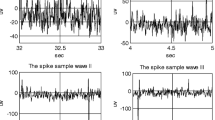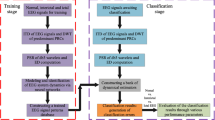Abstract
Subdural electroencephalograms (SEEGs) are of great value in localizing primary epileptogenic regions in patients undergoing evaluation for focal resective epilepsy surgery. The data segments which contain a transition from interictal to ictal activity carry the most critical diagnostic information. Computer signal extraction within this transition period represents a challenging signal processing problem. In this work a two-step method is presented to extract early ictal activity. In the first step we employ a nonlinear signal decomposition technique in the wavelet domain to separate SEEG data into ictal and background components. In the second step we use time-frequency analysis and a novel integration algorithm to extract the desired information. Our experiments on clinically recorded data indicate that this method is highly effective allowing us to reveal important hidden features in the data which could not otherwise be observable. © 2001 Biomedical Engineering Society.
PAC01: 8719Nn, 0260Jh
Similar content being viewed by others
REFERENCES
Burrus, C. S., R. A. Gopinath, and H. Gau. Introduction to Wavelets and Wavelet Transforms, A Primer. Englewood Cliffs, NJ: Prentice-Hall, 1997.
Casdagli, M. C., L. D. Iasemidis., R. S. Savit., R. L. Gilmore., S. N. Roper., and J. C. Sackellares. Nonlinearity in invasive EEG recordings from patients with temporal lobe epilepsy. Electroencephalogr. Clin. Neurophysiol.102.:98–105., 1997.
Chui, C. K. An Introduction to Wavelets. Boston, MA: Academic, 1992.
Cohen, A., I. Daubechies., and J. C. Feauveau. Biorthogonal bases of compactly supported wavelets. Commun. Pure Appl. Math.45.:485–560., 1992.
Cohen, L. Time-Frequency Analysis. Englewood Cliffs, NJ: Prentice-Hall, 1995.
Daubechies, I..Orthonormal bases of compactly supported wavelets. Commun. Pure Appl. Math.41.:909–996., 1992.
Donoho, D. L., and I. M. Johnstone. Ideal spatial adaptation by wavelet shrinkage. Biometrika.81.:425–455., 1994.
Donoho, D. L., I. M. Johnstone., G. Kerkyacharian., and D. Picard. Wavelet shrinkage: asymptopia?.J. Royal Stat. Soc. B.57.:301–365., 1995.
Hlawatsch, F., and G. F. Boudreaux-Bartels. Linear and quadratic time-frequency signal representation. IEEE Signal Process. Mag. 21–67, 1992.
Iasemidis, L. D., K. E. Pappas, J. C. Principe, and J. C. Sackellares. Spatiotemporal dynamics of human epileptic seizures. In: Proc. 3rd Experimental Chaos Conference, Singapore: World Scientific, 1996, pp. 26–30.
Iasemidis, L. D., J. C. Principe, J. M. Czaplewski, R. L. Gilmore, S. N. Roper, and J. C. Sackellares: Spatiotemporal transition to epileptic seizures: A nonlinear dynamical analysis of scalp and intracranial EEG recordings. In: Spatiotemporal Models in Biological Artificial Systems, edited by Silva et al. Washington DC: IOS, 1997, pp. 81–88.
Wieser, H. G..Epilepsy surgery: Past, present and future. Seizure.7.:173–184., 1998.
Oppenheim, A. V., and R. W. Schafer. Discrete-Time Signal Processing. Englewood Cliffs, NJ: Prentice-Hall, 1989.
Rabiner, L. R., and B. Gold. Theory and Application of Digital Signal Processing. Englewood Cliffs, NJ: Prentice-Hall, 1975.
Le Van Quyen, M., C. Adam., M. Baulac., J. Martinerie., and F. J. Varela. Nonlinear interdependencies of EEG signals in human intracranially recorded temporal lobe seizures. Brain Res.792.:24–40., 1998.
Mallat, S. G. A Wavelet Tour of Signal Processing. Boston, MA: Academic, 1998.
Schiff, S. J., P. So., and T. Chang. Detecting dynamical interdependence and generalized synchrony through mutual prediction in a neural ensemble. Phys. Rev.54.:6708–6724., 1996.
Stam, C. J., J. Nicolai., and R. W. Keunen. Nonlinear dynamical analysis of periodic lateralized epileptiform discharges. Clin Electroencephalogr.29.:101–105., 1998.
Sun, M., C-C. Li., L. N. Sekhar., and R. J. Sclabassi. Efficient computation of discrete pseudo-Wigner distribution. IEEE Trans. Acoust., Speech, Signal Process.37.:1135–1142., 1989.
Yaylali, I., H. Kocak., and P. Jayakar. Detection of seizures from small samples using nonlinear dynamic system theory. IEEE Trans. Biomed. Eng.43.:743–751., 1996.
Author information
Authors and Affiliations
Rights and permissions
About this article
Cite this article
Sun, M., Scheuer, M.L. & Sclabassi, R.J. Extraction and Analysis of Early Ictal Activity in Subdural Electroencephalogram. Annals of Biomedical Engineering 29, 878–886 (2001). https://doi.org/10.1114/1.1408928
Issue Date:
DOI: https://doi.org/10.1114/1.1408928




